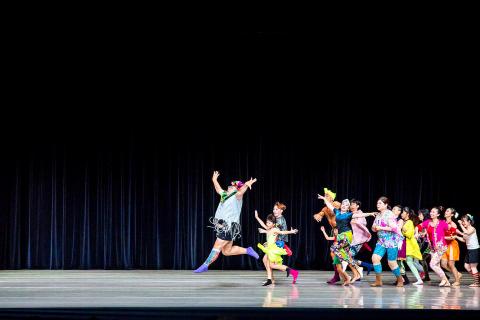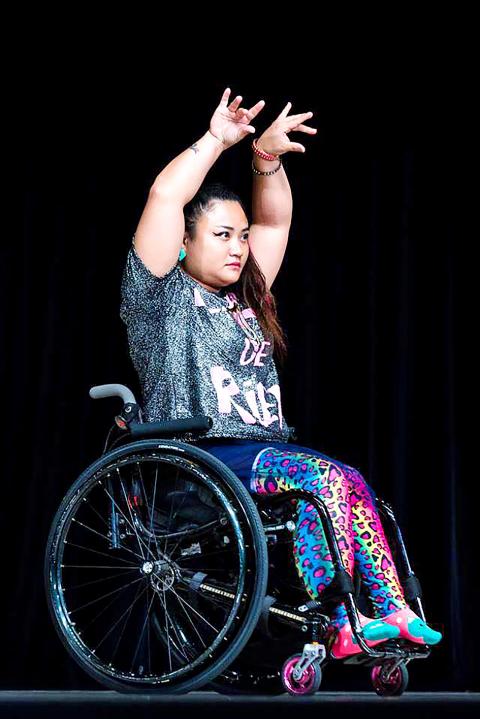Swans usually mate for life. On Friday night at the National Theater, I found myself thinking that it was a good thing that both Prince Siegfried and Odette die at the end of Moscow Classical Ballet’s version of Swan Lake because otherwise they would be looking at decades of a loveless, if not sexless marriage.
That was even before the end of Act II, the big “romantic meet” of the ballet, with two acts left to go.
Company stars Marina Rzhannikova danced Odette/Odile, with Artem Khoroshilov as Siegfried, but they appeared to have as much chemistry as a pair of dead fish lying next to each other on ice at a market.

Photo courtesy of Gelee Lai
Swan Lake is all about passion — and fluid arms. For the illusion to work, the audience has to believe through the dancing and storytelling mime that the prince has fallen madly in love with the enchanted swan maiden. They also have to believe, and this comes mostly through the leading ballerina’s port de bras or arm movements, that Odette can change from human to swan.
I have seen some truly great ballerinas dance Odette over the years: Eva Evdokimova with the Berlin Oper Ballet was the first to take my breath away with her rippling arms at the end of Act II. The great Russian Natalia Makarova dancing with the American Ballet Theater was another who was absolutely spellbinding in the role.
I watched YouTube videos of Rzhannikova in performances from 1988 and later: Her arms were so expressive, as was the rest of her performance.

Photo courtesy of Gelee Lai
For whatever reason, jet lag, injury, bored from dancing the same role day in and day out, on Friday her arms were leaden, as was most of her acting.
However, she still had more expressiveness that Khoroshilov. He is not a bad dancer, but he was certainly no love-struck prince.
When he realized that he has betrayed Odette by asking Odile (danced by Rzhannikova with more flair than she showed as Odette) to marry him, he seemed about as upset as someone who just found out that his dentist canceled his next appointment.
What should have been a climactic battle between Siegfried and the evil magician Von Rothbart (Alexey Orlov) in Act IV, where the prince tears off Von Rothbart’s winged cape to rob him of his powers and free the swan maidens from their curse, Khoroshilov looked more like a maitre d’ carefully removing a mink coat from the shoulders of a wealthy customer, at least up to the point where he just dropped it on the floor.
The cape — which is a stunner — was obviously not designed, like those in some productions, to be torn in two, but I blamed Khoroshilov for the very undramatic scene. After looking at some of the video clips again when I went home, I realized that it was the choreography that was at fault.
However, there were several things to like about Moscow Classical Ballet’s production: the costumes in Act I and Act III were dazzling, and the staging, though simple as needed for a traveling production, had some lovely backdrops and the bird-patterned scrim is a nice touch.
Vladislav Dubenko was a terrific as the jester. He looked like he was having fun every minute he was dancing, and his dancing was very good. Galina Garmash is tiny, but she sparkled in the Waltz Solo in Act I.
In Act III, Ekaterina Silantieva was terrific as the Venetian fiancee, Viktoriia Soloveva and Margarita Popova sizzled as the female half of the Spanish Dance and the corps de ballet dancers looked good in the national dances.
As for the fabled flock of swans in Act II and Act IV, there were some mishaps, with one of the quartet of baby swans dancing a bit out of sync in what is supposed to be an example of flawless unity, but for the most part the women acquitted themselves well, as did their male colleagues in the Goblet Dance in Act I.
If the company comes back, it would be nice to see others in the leading roles.
A GALA TO CELEBRATE
Thankfully, Friday night’s show was easily forgotten by seeing French choreographer Jerome Bel’s Gala at Taipei’s Zhongshan Hall on Saturday as part of the Taipei Arts Festival.
Designed as a celebration of individualism, amateurism, community, but most of all fun, Bel said he wanted to make a piece that was accessible to people of all ages and backgrounds.
He succeeded admirably.
My only complaint was that I could have done with a shorter slideshow of empty theaters around the world that begins the show. It serves to quiet the audience and remind them that stages and performances venues can be very old, very grand, very simple or just an open space, but I was impatient for the dancing to begin.
It did with the first cast member bringing out a flip chart with the word “ballet” in Chinese and English written on it, and then performing two pirouettes as an excerpt from Giselle is heard. She was followed, one by one, by the others, clad in a wide variety of clothes, costume parts, patterned leggings and sequins. Their attempts at the spins were equally varied, from the experienced — there were several graduates of Taipei National University of the Arts’ dance department in the cast — to the extremely awkward, but they served to introduce each person.
The segues from one segment to the next were marked by new pages on the flip chart: from waltz, to solo, to silent and so on.
By the end, when the cast had switched costumes, several had the chance to act as dance leaders for the rest, the audience was cheering and clapping, and in some cases, crying.
Among my favorite dance leaders were Wang Fei-fain (汪飛帆), a professional drag queen who brought down the house as she lipsynced Brooke Candy’s Don’t Touch My Hair Hoe, parading from one side of the stage to the other, with the others rocking along behind.
Tseng Yu-ting (曾玉婷) showed that you do not need to depend on your feet to dance as she rolled and spun in her wheelchair.
Rhythmic gymnast Fang Jui-Chun’s (方睿君) showed a flair with a ribbon stick that the others gamefully tried to copy, but often ended up wrapped up in the ribbon instead; and Comei (廖治強) proved that size does not matter when leaping around the stage.
Chang Jui-chia (張芮嘉) and Chung Hsu-han (鍾序涵) might have been the youngest, but they were a delight to watch.
Everyone deserved applause, especially considering they had met for the first time just five days before the first show. The rest of the cast was composed of dancers Mauro Sacchi, Chou Tzu-ching (周孜靜), Huang Yen-lin (黃彥霖) and Liao Chien-shun (廖健舜); Lin Pin-han (林品翰), Lin Siao-ting (林小婷), Lee Ke-feng (李可楓), Indrawati Tanoto, Chang Chia-hsuan (鍾序涵), Cheng Hsin-yi (鄭欣怡), Liu I-shiang (劉翼翔), Chung Sheng-hsieh (鍾勝劦), Hsieh Yi-yen (謝宜晏) and Wei Ming-chao (魏明朝).
ENJOYABLE KCB
The previous weekend I traveled to Kaohsiung to see Kaohsiung City Ballet’s (高雄城市芭蕾舞團) 19th Century Romanic Ballets (世紀浪漫芭蕾—仙女—吉賽兒—四人舞) at the Kaohsiung Cultural Center.
Romanian Constantin Georgescu served as researcher and rehearsal director for the show, crafting a recreation of Pas de Quatre and working with artistic director Chang Hsiu-ru’s (張秀如) on the excerpts from Giselle and La Sylphide.
While the Moscow Classical Ballet’s dancers might have more finely honed techniques, the KCB’s dancers acquitted themselves admirably, helped along by guest artist Chung Chang-hung (鍾長宏), who has danced with the State Street Ballet in California and the Greek National Opera ballet.
He did not have all that much to do except partner Kuo Jung-an (郭蓉安) in their variation from Giselle, but the segment from La Sylphide gave him a chance to show his talent, and he took full advantage.
I was also impressed with Kuo’s line. Other standouts were Ally Yeh Li-chuan (葉麗娟), Hsia Chia-hui (夏嘉徽), Chang Hu-mai (張護邁) and Hsu Chia-jung (許佳蓉).
The company’s final performance of 19th Century Romanic Ballets will be at the Taichung National Theater on Sept. 11.

June 9 to June 15 A photo of two men riding trendy high-wheel Penny-Farthing bicycles past a Qing Dynasty gate aptly captures the essence of Taipei in 1897 — a newly colonized city on the cusp of great change. The Japanese began making significant modifications to the cityscape in 1899, tearing down Qing-era structures, widening boulevards and installing Western-style infrastructure and buildings. The photographer, Minosuke Imamura, only spent a year in Taiwan as a cartographer for the governor-general’s office, but he left behind a treasure trove of 130 images showing life at the onset of Japanese rule, spanning July 1897 to

One of the most important gripes that Taiwanese have about the Democratic Progressive Party (DPP) is that it has failed to deliver concretely on higher wages, housing prices and other bread-and-butter issues. The parallel complaint is that the DPP cares only about glamor issues, such as removing markers of Chinese Nationalist Party (KMT) colonialism by renaming them, or what the KMT codes as “de-Sinification.” Once again, as a critical election looms, the DPP is presenting evidence for that charge. The KMT was quick to jump on the recent proposal of the Ministry of the Interior (MOI) to rename roads that symbolize

In an interview posted online by United Daily News (UDN) on May 26, current Chinese Nationalist Party (KMT) Chairman Eric Chu (朱立倫) was asked about Taichung Mayor Lu Shiow-yen (盧秀燕) replacing him as party chair. Though not yet officially running, by the customs of Taiwan politics, Lu has been signalling she is both running for party chair and to be the party’s 2028 presidential candidate. She told an international media outlet that she was considering a run. She also gave a speech in Keelung on national priorities and foreign affairs. For details, see the May 23 edition of this column,

On the evening of June 1, Control Yuan Secretary-General Lee Chun-yi (李俊俋) apologized and resigned in disgrace. His crime was instructing his driver to use a Control Yuan vehicle to transport his dog to a pet grooming salon. The Control Yuan is the government branch that investigates, audits and impeaches government officials for, among other things, misuse of government funds, so his misuse of a government vehicle was highly inappropriate. If this story were told to anyone living in the golden era of swaggering gangsters, flashy nouveau riche businessmen, and corrupt “black gold” politics of the 1980s and 1990s, they would have laughed.